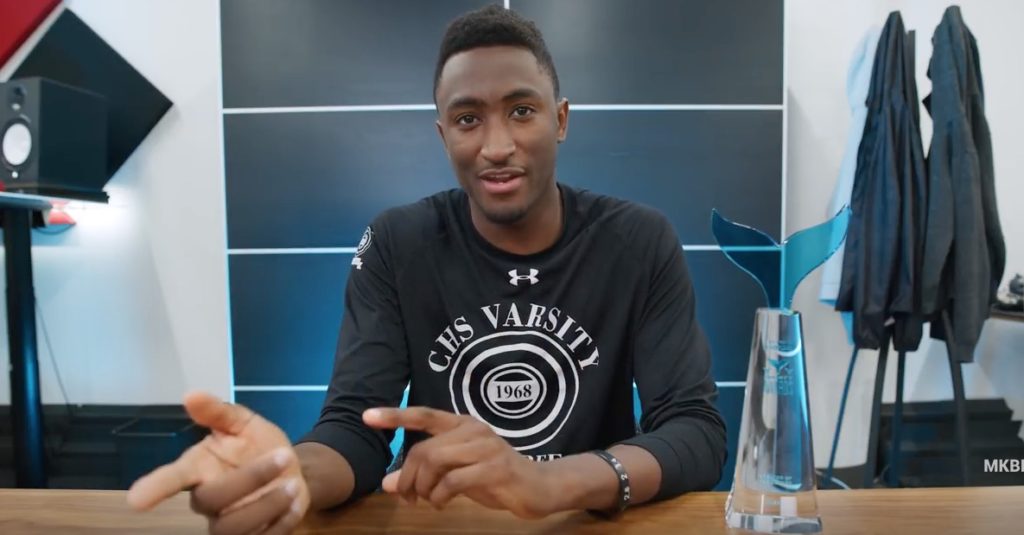Students of mobile moviemaking can find dozens of lessons in Syed Ahmad Afzal’s “YOU and I.” Honored at many festivals including the Accolade Global Film Competition (San Diego, USA) and Red Corner Film Festival (Sweden), the film demonstrates the astonishing visual qualities that can be obtained shooting with an iPhone. In about 11 minutes, the film incorporates almost every cinematic technique (reverse angles, POV, close-ups, etc.) to further the story. But even more impressive is the innovative use of voice-over dialogue: capturing an intense conversation without lip syncing. As the director explains in the interview that follows, this approach was economical while creating an acting challenge for his talented star. This is a work that is definitely worth repeated viewings for anyone who aspires to create memorable smartphone movies.
Interview with Syed Ahmad Afzal
MMM: Could you tell us how you became a filmmaker?
Afzal: I never went to a film school, neither did I read books on filmmaking. I was good at writing stories since my childhood and that helped me a great deal. Academically speaking, I am a graduate in Mechanical Engineering and worked as an engineer for quite a few years in New Delhi. Both my parents, being academicians, always used to tell me that I am good at storytelling and I should take up Arts after my 10th Grade. At first, I didn’t take them seriously but one day, I found my calling and began self teaching myself the technicalities involved in writing a screenplay.
MMM: How did you do that?
Afzal: I studied published scripts available on the web. In one month I made myself well accustomed with screenwriting and then packed up my bags and came to Mumbai in 2008. My actual struggle to becoming a filmmaker had just started. I did lot of ghost-writing in the Hindi film Industry to sustain myself. I strongly feel that there are only two ways of becoming a filmmaker—either you assist established directors on quite a number of films before directing your own or you write a very good script and then pitch it to producers in the hope of convincing one of them to make a film out of that script. I chose the latter and continued writing scripts, one after another, till five years later a leading producer green-lit one of my scripts and signed me as a director to make my first ever mainstream feature length film.
MMM: Is there some filmmaker who most influenced you?
Afzal: Each film that I have seen has taught me something. But the three who’ve inspired me the most are Andrei Tarkovsky for his IMAGERY, Akira Kurosawa for his TECHNIQUE, and Christopher Nolan for his NARRATIVE.
MMM: How did you come up with the idea for “YOU and I”?
Afzal: The idea behind “YOU and I” was to create a conversation between two people, while they’re separated from each other. They know each other so well, yet they’re not able to arrive at the decision of letting it all go.
MMM: Why did you decide to shoot using the iPhone as opposed to a traditional camera?
Afzal: I had just watched ‘Tangerine”‘ by the brilliant Sean Baker and was quite kicked about shooting with the iPhone myself. And I had this very vague idea that I wanted to translate on screen and the iPhone format suited it very well. So there was no question of a traditional camera.
MMM: What are the advantages of shooting with a smartphone?
Afzal: For one thing, you can shoot with a very limited crew. Then, because the iPhone is so light and small it fits into very odd spaces to create unimaginable angles. Also, you can shoot guerrilla style on real locations without inviting any attention from the public or authorities. Actors tell me that iPhone or any other smartphone as a camera doesn’t intimidate them and they’re less camera conscious performing in front of it in comparison to a traditional camera. And finally, it’s very cost effective.
MMM: And the disadvantages?
Afzal: It gives lot of grains in low light, which is a problem in poor lighting situations, especially at night. The footage tends to become grainy even in daylight sometimes; then you need to de-grain it in post. There are also battery issues. The iPhone tends to heat up, while shooting. If you don’t have reasonable internal storage on your iPhone, transferring footage to your Macbook is a frustrating task while shooting. And finally, I find that the iPhone screen is too small for good judgement on exposure, focus, etc.
MMM: Could you talk about your decision to use voice-over?
Afzal: We just had the gist of the story with us and there was no script in place. I and Tara (my lead actor) decided to shoot montages and then make a proper story out of it on the edit table. I even wrote the dialogue after finishing the final cut of the film. We found this process to be very organic and fulfilling. I had imagined the conversation happening in the mind of my characters and therefore we thought of incorporating the voice-over. It was definitely more economical. Shooting is quicker and easier without the live sync sound equipment, which would’ve added an astronomical amount to our budget.
MMM: Although we hear the voice of your protagonist played by Tara Alisha Berry, in reality “YOU and I” illustrates non-verbal acting. Could you discuss what it takes to direct that kind of performance?
Afzal: It’s very difficult to perform a non-talking character especially when there is no script in place. You’re dependent on the craft of building up emotions within you and letting your face express it. And I must say Tara did a brilliant job of portraying the character’s inner feeling and emotions using only her expressions. She’s one actor who understands the consistency of emotion very well. We just discussed the emotion before each montage and she performed accordingly. Not once did it appear to me that she was acting. It was so natural.
MMM: The story unfolds in many visually arresting locations. Could you tell us how you went about choosing them?
Afzal: Frankly speaking, we had not done any location scouting before embarking upon the shoot. The location selection was spontaneous. We shot wherever we could—at the beach, next to a railway line, in the car, etc. Since we had the iPhone as our camera, we were not attracting any attention from the authorities or people on the road. And that’s the reason thankfully we didn’t face any interruptions while shooting on these real locations.
MMM:Could you talk about the gear used in the shooting?
Afzal: We used the iPhone 6S Plus as our camera. DJI OSMO Mobile and iOgrapher were used as the stabilisation devices. Since the lenses were heavy for the OSMO gimbal to hold, we used some 10 to 12 coins as counter balance and it worked. We also employed Moment lenses (wide, tele, macro) and iOgrapher lenses (super wide angle, macro).
MMM: Anything else?
Afzal: We used FiLMiC Pro, which is a boon to mobile moviemakers. It gives you the freedom of shooting LOG MODE on your iPhone, controlling the White Balance, Exposure and other very special features. And the best part is that we dubbed those Voice-Overs on the iPhone with the help of an attached RODE Mic. My sound designer friend had told me that iPhone is great for voice recordings. He advised me to record the Voice-Overs inside a locked car in the middle of the night, which gives the sound proof ambience of a dubbing studio. We did that and it gave us such unexpected results. We even captured the making-of stills and videos using an iPhone. The stills were later used to illustrate our official posters.
MMM: During the production, did you encounter any big challenge? If yes, how did you solve it?
Afzal: The entire process was a challenge to us, because we had never before thought of creating something on an iPhone. Limited resources in filmmaking always compels you to think harder and out of the box. Anything that is done with utmost conviction and perseverance is bound to create good results.
MMM: Do you plan to shoot with a smartphone in the future or was this a one-time experiment?
Afzal: We are quite pleasantly surprised with the results. I plan to create more independent content—even a feature— which could be shot using a mobile phone. If the content/idea from the germ level is designed to suit the format of mobile moviemaking, there is no looking back. Mobile moviemaking is a boon to independent cinema.
MMM: What advice can you give someone just starting out as a moviemaker?
Afzal: WRITE first. Even if you’re NOT a Writer.
# # #
You can follow Syed Ahmad Afzal Twitter, Facebook, Instagram, YouTube, and IMDb. Trailers for his three Hindi language feature films may be seen at LAAL RANG, YOUNGISTAAN, and BAARAAT COMPANY
“YOU and I” was chosen by the editors of MobileMovieMaking as a Mobile Movie of the Week.



 Previous post
Previous post
 Next post
Next post





